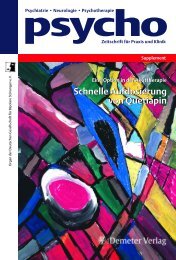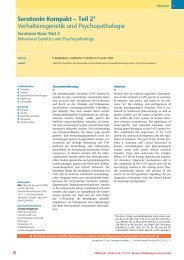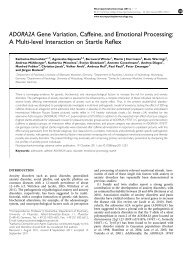Genome-wide linkage analysis of ADHD using high- density SNP ...
Genome-wide linkage analysis of ADHD using high- density SNP ...
Genome-wide linkage analysis of ADHD using high- density SNP ...
You also want an ePaper? Increase the reach of your titles
YUMPU automatically turns print PDFs into web optimized ePapers that Google loves.
should be detectable in all or several families.<br />
(2) Within each pedigree, diminished genetic heterogeneity<br />
can be assumed 15 ; thus, strong family-specific<br />
gene effects are also likely to be found, which may or<br />
may not be extrapolated to general populations with<br />
<strong>ADHD</strong>. Family members were classified into a<br />
category <strong>of</strong> four, that is, definite <strong>ADHD</strong>; subclinical<br />
<strong>ADHD</strong> symptoms; no <strong>ADHD</strong>; unknown. For <strong>analysis</strong><br />
<strong>of</strong> the narrow phenotype, subclinically affected<br />
individuals were classified as not affected, whereas<br />
for <strong>analysis</strong> <strong>of</strong> the broad phenotype they were<br />
classified as affected. We applied both parametric<br />
<strong>analysis</strong> methods maximizing logarithm <strong>of</strong> the odds<br />
ratio (LOD) scores for chromosomal sections (B500<br />
<strong>SNP</strong>s; MODglobal) or for single marker position<br />
(MODsingle) and a non-parametric approach (NPL).<br />
Methods<br />
Ascertainment and assessment<br />
We ascertained families <strong>of</strong> German origin through<br />
index children referred to three outpatient clinics in<br />
Wuerzburg, Homburg or Trier. The structure <strong>of</strong> the<br />
eight families (Pedigree 1–8; P1–P8) is shown in<br />
Figure 1 and summarized in Table 1. For the index<br />
child, strict inclusion and exclusion criteria were<br />
applied. Included index children were aged 6 or<br />
above, meeting criteria for the <strong>ADHD</strong> combined type<br />
according to DSM-IV. Index children that had a birth<br />
weight > 2000 g did not show any neurological or<br />
severe somatic disorder, drug abuse or autistic<br />
<strong>Genome</strong>-<strong>wide</strong> <strong>linkage</strong> <strong>analysis</strong> <strong>of</strong> <strong>ADHD</strong><br />
M Romanos et al<br />
disorder and did not receive medication with central<br />
nervous effect (with the exception <strong>of</strong> methylphenidate).<br />
IQ was > 80. P1, P2, P3 and P4 were recruited<br />
in Wuerzburg; P5, P6, P7 and P8 in Homburg and<br />
Trier. When parents reported individuals in the<br />
extended family with presumable or definite affection<br />
with <strong>ADHD</strong>, pedigrees were drawn to determine<br />
family size and structure. Reported <strong>ADHD</strong> symptoms<br />
in more than two generations resulted in intensified<br />
recruitment <strong>of</strong> further family members either by<br />
invitation to our <strong>ADHD</strong> family outpatient clinic or<br />
by home visits. All participants signed informed<br />
written consent. The study was approved by the<br />
Ethics Committees <strong>of</strong> the Julius-Maximilians-University<br />
<strong>of</strong> Wuerzburg and the Saarland Doctors’ Association<br />
(SaarlÄndische Ärztekammer), respectively.<br />
Bilineality was not an exclusion criterion for<br />
recruitment, since it was presumably present in most<br />
recruited families. While bilineal families were<br />
excluded from ascertainment in the study by Arcos-<br />
Burgos et al., 14 a similar approach was not considered<br />
useful, since intra-familiar heterogeneity cannot be<br />
completely ruled out in complex traits. We recruited<br />
extended families that were non-related bearing in<br />
mind the possibility that different major gene effects<br />
might exist within the respective families.<br />
Children and adolescents were clinically characterized<br />
by a semi-structured interview (Kiddie-Sads-PL<br />
German version 16 or Kinder-DIPS 17 ), child behavior<br />
checklist (CBCL) 18 and by an <strong>ADHD</strong> diagnostic<br />
checklist applying DSM-IV criteria categorically and<br />
Figure 1 Pedigree structure <strong>of</strong> families. Individuals with a diagnosis <strong>of</strong> attention-deficit/hyperactivity disorder (<strong>ADHD</strong>) are<br />
depicted by black, the subclinical phenotype is represented by gray symbols. Unaffected family members are shown by white<br />
symbols, and individuals with unknown <strong>ADHD</strong> status are marked with a black circle in the symbol. A black dot beneath an<br />
individual indicates that DNA was available for genetic evaluation. Pedigrees are modified to preserve confidentiality.<br />
523<br />
Molecular Psychiatry








